
Fountains Abbey is one of the largest and best preserved ruined Cistercian monasteries in England. It is located approximately 3 miles (5 km) south-west of Ripon in North Yorkshire, near to the village of Aldfield. Founded in 1132, the abbey operated for 407 years, becoming one of the wealthiest monasteries in England until its dissolution, by order of Henry VIII, in 1539.
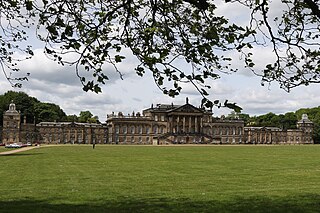
Wentworth Woodhouse is a Grade I listed country house in the village of Wentworth, in the Metropolitan Borough of Rotherham in South Yorkshire, England. It is currently owned by the Wentworth Woodhouse Preservation Trust. The building has more than 300 rooms, with 250,000 square feet (23,000 m2) of floorspace, including 124,600 square feet (11,580 m2) of living area. It covers an area of more than 2.5 acres (1.0 ha), and is surrounded by a 180-acre (73 ha) park, and an estate of 15,000 acres (6,100 ha).

The Cathedral Church of St Peter and St Wilfrid, commonly known as Ripon Cathedral, and until 1836 known as Ripon Minster, is a cathedral in Ripon, North Yorkshire, England. Founded as a monastery by monks of the Irish tradition in the 660s, it was refounded as a Benedictine monastery by St Wilfrid in 672. The church became collegiate in the tenth century, and acted as a mother church within the large Diocese of York for the remainder of the Middle Ages. The present church is the fourth, and was built between the 13th and 16th centuries. In 1836 the church became the cathedral for the Diocese of Ripon. In 2014 the Diocese was incorporated into the new Diocese of Leeds, and the church became one of three co-equal cathedrals of the Bishop of Leeds.

The Abbey of St Mary is a ruined Benedictine abbey in York, England and a scheduled monument.

Malton is a market town, civil parish and electoral ward in North Yorkshire, England. Historically part of the North Riding of Yorkshire, the town has a population measured for both the civil parish and the electoral ward at the 2011 Census as 4,888.
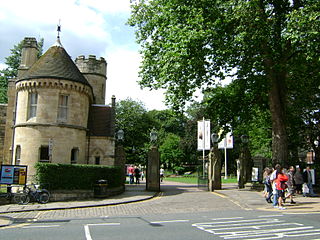
The York Museum Gardens are botanic gardens in the centre of York, England, beside the River Ouse. They cover an area of 10 acres (4.0 ha) of the former grounds of St Mary's Abbey, and were created in the 1830s by the Yorkshire Philosophical Society along with the Yorkshire Museum which they contain.

The Yorkshire Philosophical Society (YPS) is a charitable learned society which aims to promote the public understanding of the natural sciences, the social sciences, and the archaeology and history of York and Yorkshire.
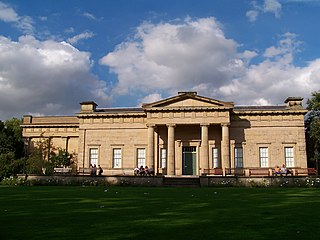
The Yorkshire Museum is a museum in York, England. It was opened in 1830, and has five permanent collections, covering biology, geology, archaeology, numismatics and astronomy.

King's Square is an open area in the city centre of York, in England. It is popular with tourists, who are often entertained by buskers and street performers. Nikolaus Pevsner notes that "the square has trees, which distinguishes it". The York's Chocolate Story attraction lies on the western side of the square.

Duncombe Place is a street in the city centre of York, in England.

Dalton Parlours Roman villa is a Roman villa and scheduled monument near Collingham, West Yorkshire.

Precentor's Court is an historic street in the English city of York. Although certainly in existence by 1313, the street does not appear on a map until 1610, and it is not given a name until 1722. It was given its current name exactly a century later.

Fenton House is an historic building in the English city of York, North Yorkshire. It is a Grade II* listed structure, standing at 9 Precentor's Court.

The York Arms is an historic building in the English city of York, North Yorkshire. It was designed by James Pigott Pritchett. Part of a seven-unit row that is a Grade II listed structure dating to 1838, it faces south at 26 High Petergate. These units are sandwiched between early-18th-century properties. The rear of the properties to the north, on Precentor's Court, are also part of the listing. They were originally residences for canons of the adjacent York Minster.
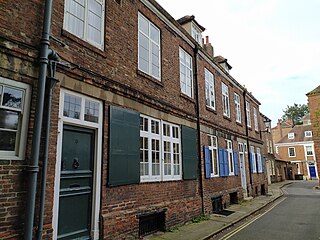
2, 3, 4, and 4a Precentor's Court is an historic row of three buildings in the English city of York, North Yorkshire. Grade II* listed structures, standing on Precentor's Court, the buildings date to around 1710.

5 Precentor's Court is an historic building in the English city of York, North Yorkshire. A Grade II* listed structure, standing on Precentor's Court, the building dates to the early 18th century.
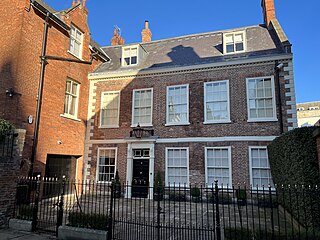
10 Precentor's Court is an historic building in the English city of York, North Yorkshire.

Whitefriargate is a pedestrianised street in the Old Town area of Kingston upon Hull, in the East Riding of Yorkshire, England. During the 20th century, it was one of the main shopping streets in the city centre, but some of the major stores have closed down, which has been attributed to out of town shopping centres. However, the Street still provides a useful link to and from the old town of Hull.

Purey-Cust Lodge is an historic building in the English city of York, North Yorkshire. Now Grade II listed, it dates to 1845. Prior to this date, it was the stone yard for York Minster.

Purey-Cust Lodge boundary wall is an historic structure in the English city of York, North Yorkshire. A Grade II listed building, it dates to 1845.





















